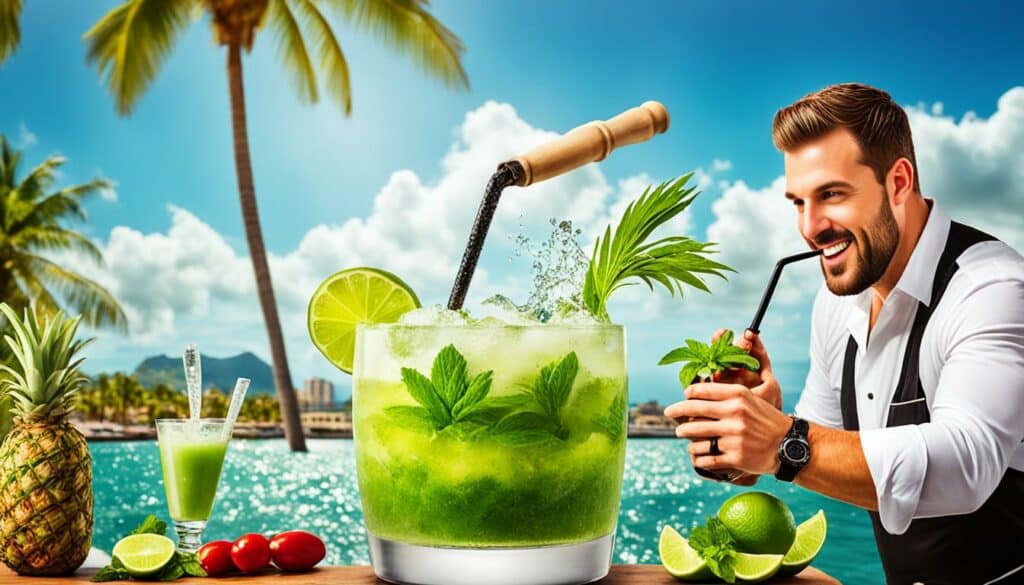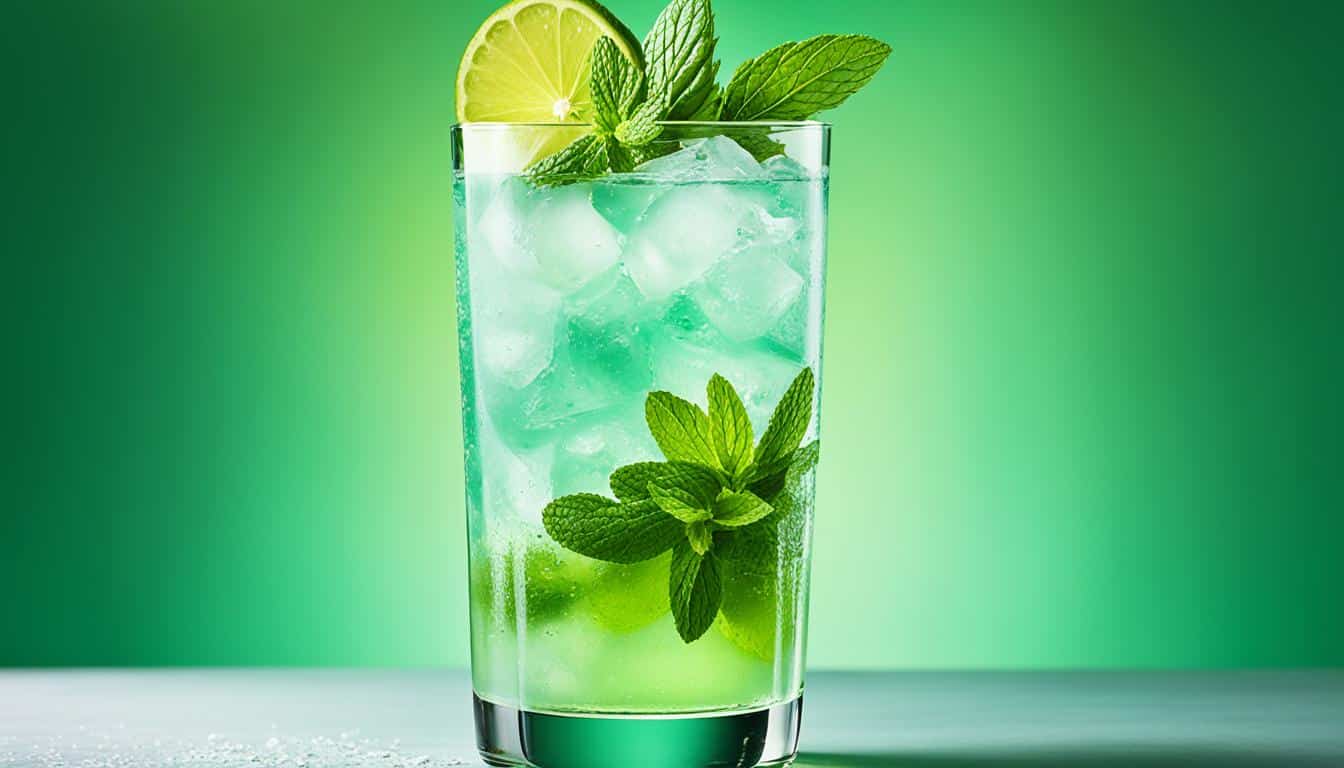The Mojito cocktail has a fascinating history that takes us back to its origins in Cuba. Contrary to popular belief, this iconic drink did not originate in Mexico, but rather in the vibrant streets of Havana. So, where is the Mojito cocktail from and what is its true origin?
Like many aspects of Cuban culture, the Mojito has been influenced by Spain, which colonized both Cuba and Mexico. However, the Mojito’s roots are firmly planted in the bustling bars and cafes of Havana, where it first gained popularity.
The true history of the Mojito is a bit uncertain, with different stories claiming its origins. One version suggests that it was originally a medicinal drink in Cuba, made with moonshine rum, mint, lime, and sugar cane syrup. Another tale links the Mojito to Pirate Drake, who reportedly added rum to the concoction, leading to its eventual name change to Mojito.
Regardless of its exact origins, the Mojito captured the attention of renowned writer Ernest Hemingway, who became a fan of the drink during his time in Cuba. Its popularity further soared through appearances in popular films, solidifying its status as a beloved cocktail.
Key Takeaways:
- The Mojito cocktail originates from Cuba, not Mexico.
- Its exact origin is uncertain, with various stories claiming its creation.
- The Mojito gained popularity with Ernest Hemingway and through its appearances in popular films.
- Regardless of its origins, the Mojito has become a globally popular cocktail.
- The Mojito was the most popular global cocktail in 2013.
The Mojito’s History and Evolution
The Mojito cocktail has a rich history that traces back to the 16th century. It is believed to have been born out of a desire to create a drink that reflects Cuban culture.
Sir Francis Drake and his crew played a significant role in the early history of the Mojito. They landed in Cuba and used a primitive form of rum called aguardiente, along with lime, sugarcane juice, and mint, to fend off scurvy and dysentery.
Over the centuries, the Mojito recipe evolved to include indigenous ingredients like sugarcane juice, lime, and mint. The name “Mojito” is derived from the African word “mojo,” meaning to place a little spell. This reflects the cocktail’s enchanting qualities.
“The Mojito is a drink that can cast a spell on you with its refreshing taste and invigorating aroma. It embodies the vibrant spirit of Cuba, transporting you to sun-soaked beaches and colorful streets.”
The Mojito gained international recognition during the late 19th century when American tourists visiting Cuba during Prohibition discovered and popularized the drink.
The Mojito’s Cultural Influence
The Mojito has become an iconic symbol of Cuban culture and its ties to vibrant cocktails. The art of crafting the perfect Mojito has been passed down through generations, ensuring its authenticity and cultural significance.
The Mojito’s popularity continues to soar, with its refreshing flavors and timeless appeal captivating cocktail enthusiasts worldwide.
| Year | Event |
|---|---|
| 19th Century | The Mojito gains popularity among American tourists visiting Cuba during Prohibition. |
| 1920s | The Mojito is embraced by socialites and celebrities, including Ernest Hemingway. |
| 21st Century | The Mojito becomes one of the most popular and iconic cocktails globally. |
Today, the Mojito remains a beloved classic, capturing the essence of Cuba’s rich history and vibrant cocktail culture.
Crafting the Perfect Mojito
To make an authentic Cuban Mojito, you’ll need to gather the essential ingredients. The classic recipe consists of:
- White Bacardi rum
- Spearmint or yerba buena
- Cane sugar or cane syrup
- Lime juice
- Soda or mineral water
To ensure the perfect blend of flavors, it’s important to follow a specific technique. Begin by gently bruising the mint leaves to release their essential oils without cutting them. This process enhances the aroma and taste of the drink. Next, combine the mint leaves, rum, lime juice, and sugar in a glass or cocktail shaker. Mix the ingredients thoroughly until the sugar dissolves.
Finally, add crushed ice to the glass and top it off with soda or mineral water. Give the mixture a gentle stir, ensuring all the ingredients are well incorporated. For the finishing touch, garnish your Mojito with a sprig of mint. The fragrant mint and citrusy lime create a refreshing and classic Mojito experience.
If you prefer a sweeter or less bubbly taste, feel free to adjust the amount of soda or sugar to suit your personal preference. The traditional recipe serves as a great base but allows for customization to cater to individual palates.
The Rise of the Mojito’s Popularity
Although the Mojito has been a beloved Cuban drink for centuries, its international popularity saw a rise in the late 19th century. The Prohibition era in the United States brought a significant influx of American tourists to Cuba, who discovered and embraced the Mojito. Its refreshing taste and vibrant presentation appealed to the masses, leading to its widespread adoption in bars and restaurants across the United States and beyond. The Mojito’s rise in popularity was also influenced by its association with celebrities like Ernest Hemingway, Brigitte Bardot, and Errol Flynn. The Mojito even made appearances in popular films, such as being used by James Bond to seduce a character in “Die Another Day.”

Mojito’s Celebrity Associations
“The Mojito is my favorite drink, whether I win or lose.” – Ernest Hemingway
“A Mojito in hand is a tropical vacation in a glass.” – Brigitte Bardot
“The Mojito adds a touch of sophistication to any occasion.” – Errol Flynn
| Celebrity | Association with the Mojito |
|---|---|
| Ernest Hemingway | Declared it as his favorite drink, adding to its allure and popularity. |
| Brigitte Bardot | Helped popularize the Mojito by expressing her love for the cocktail. |
| Errol Flynn | Associated the Mojito with sophistication and elegance, contributing to its rise in popularity. |
Variations of the Mojito
While the classic Mojito recipe remains a favorite, mixologists around the world have put their own spin on this iconic cocktail. Some popular variations include:
- Strawberry Mojito: Adding fresh strawberries for a fruity twist.
- Coconut Mojito: Replacing the club soda with coconut water for a tropical flavor.
- Pineapple Mojito: Incorporating pineapple juice for a taste of the tropics.
- Mojito Mocktail: Substituting rum with sparkling water or lemon-lime soda for a non-alcoholic version.
These variations offer unique flavors and allow individuals to customize their Mojito experience. The possibilities for customization do not end there. The Mojito can also be adjusted by:
- Adding angostura bitters for an extra layer of complexity.
- Using lemon instead of lime for a tangy twist.
- Substituting rum with tequila to create a refreshing tequila-based Mojito.
The versatility of the Mojito makes it a beloved and adaptable cocktail, suitable for any occasion or preference.
Comparison of Mojito Variations
| Variation | Description |
|---|---|
| Strawberry Mojito | Classic Mojito with added fresh strawberries for a fruity twist. |
| Coconut Mojito | Mojito with coconut water instead of club soda for a tropical flavor. |
| Pineapple Mojito | Mojito with pineapple juice for a taste of the tropics. |
| Mojito Mocktail | A non-alcoholic version of the Mojito, substituting rum with sparkling water or lemon-lime soda. |
| Customized Mojito | Mojito with added angostura bitters, lemon instead of lime, or substituting rum with tequila. |

Conclusion
The Mojito cocktail, with its Cuban roots, has a fascinating history and has become a beloved and iconic drink. Its origins may be uncertain, with various stories claiming its creation, but its popularity is undeniable. From Havana to cities around the world, the Mojito has captured the hearts of cocktail enthusiasts.
The Mojito’s refreshing taste and versatility have made it a go-to choice for those craving a taste of the tropics. Whether sipped by the beach or in a lively bar, this cocktail transports drinkers to a state of relaxation and bliss. Its combination of rum, mint, and lime creates a harmonious blend of flavors that captivates the palate.
With its endless possibilities for customization, the Mojito offers something for everyone. Whether you prefer a classic recipe or want to venture into creative variations, the Mojito can be tailored to suit your preferences. So, next time you raise a glass, toast to the Mojito’s rich history and enjoy this timeless Cuban creation.
FAQ
Where is the Mojito cocktail from?
The Mojito cocktail has its origins in Cuba.
What is the history of the Mojito drink?
The true history of the Mojito is a bit uncertain, with different stories claiming its origins. One version suggests that it was originally a medicinal drink in Cuba, made with moonshine rum, mint, lime, and sugar cane syrup. Another story links the drink to Pirate Drake, who added rum to the concoction, leading to its eventual name change to Mojito.
What is the traditional Mojito recipe?
To make an authentic Cuban Mojito, it is recommended to use specific ingredients. These include white Bacardi rum, spearmint or yerba buena, cane sugar or cane syrup, lime juice, and soda or mineral water. The recipe calls for bruising the mint leaves to release their essential oils without cutting them. The ingredients are then mixed together, and the drink is garnished with a sprig of mint.
How did the Mojito’s popularity rise?
Although the Mojito has been a beloved Cuban drink for centuries, its international popularity saw a rise in the late 19th century. The Prohibition era in the United States brought a significant influx of American tourists to Cuba, who discovered and embraced the Mojito. Its refreshing taste and vibrant presentation appealed to the masses, leading to its widespread adoption in bars and restaurants across the United States and beyond.
What are some variations of the Mojito?
While the classic Mojito recipe remains a favorite, mixologists around the world have put their own spin on this iconic cocktail. Some popular variations include the Strawberry Mojito, Coconut Mojito, Pineapple Mojito, and the Mojito Mocktail.
What is the conclusion of the Mojito’s origin and history?
The Mojito cocktail, with its Cuban roots, has come a long way since its humble beginnings. From its uncertain history to its rise in global popularity, the Mojito has become a beloved and iconic cocktail. Its refreshing taste and versatility have made it a go-to choice for those seeking a taste of the tropics.














FIND US ON SOCIALS